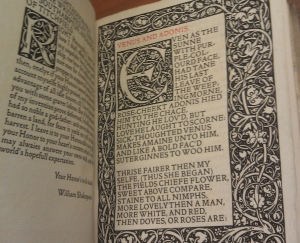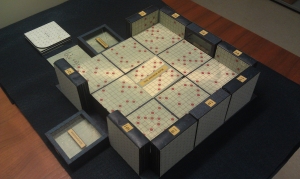
How do you define “the book”?
What functions do books serve?
What are the essential qualities of a book?
How have these characteristics changed over time?
Those are a sample of the questions raised during the Special Collections & Archives instruction sessions for the “Introduction to the History of Text Technology” classes (ENG 3803) and the “What is a Text” class (ENG 4815). For each class, we pull a variety of relevant materials from the Rare Books Collection, encouraging students to interact with the materials during the class session. The visit to Special Collections is an opportunity for students to explore in-depth the specific class themes by engaging with the rare and unique materials in Special Collections & Archives.

The concept of the codex (as seen above and left with The Poems of William Shakespeare) dominates initial discussion on the form and function of a book. But for the “Introduction to the History of Text Technology” class, we’ve placed nineteenth century ledgers alongside Babylonian cuneiform tablets that detail temple transactions from 2350 BCE, illustrating a continuity in the function, if not form of the text (see the FSU Digital Libraryrare booksrare for more information on the Cuneiform Tablet collection). For the “What is a Text?” class, students’ notions of what constitutes the essential characteristics of a book is challenged by materials from the Special Collections & Archives Artists’ Book Collection.

An artist’s book plays with the form and function of a book. By reinterpreting the text, images, or the very structure of the codex, an artist’s book pushes at the boundaries of what the essential qualities of a book should be. According to Johanna Drucker, artist and critic, the artist’s book “interrogates the conceptual or material form of the book as part of its intention, thematic interests, or production activities.”1
Many of the artists books from Special Collections & Archives abandon the structure of the codex entirely (as seen in the artist book, Fam-i-ly: a Book by Rita MacDonald, pictured right and Julie Chen’s A Guide to Higher Learning, pictured below). Other artists books play with the connection between text, image, and structure, such as in Emily Martin’s More Slices of Pie.
Special Collections & Archives has a rich collection of artists’ books, from a portfolio containing Alice’s Adventures in Wonderland illustrated by Salvador Dali to books created in the last decade that expand our notions of the essential qualities of a book. Each artist book contained in the collection is unique. Through the artist’s interpretation of text, image, and structure, the question of how to define a book is given new meaning.
For more information about artists’ books, check out this Research Guide here.

1 As cited by Megan L. Benton, “The Book as Art,” in A Companion to the History of the Book, eds. Simon Eliot and Jonathan Rose, Malden, MA: Blackwell Publishing, 2007: pg. 505.
Rebecca L. Bramlett is a graduate assistant in the Special Collections & Archives Division. She is working on her Master of Library and Information Science at Florida State University.
Very nice piece, Rebecca. I’m sure the students are getting a lot from your presentations!